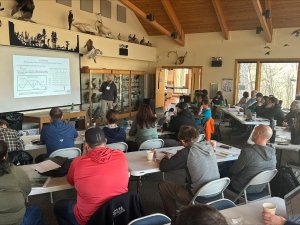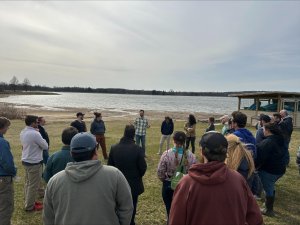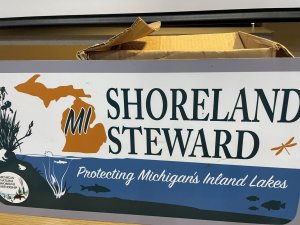Parks in Partnership Highlight: Michigan Natural Shoreline Partnership
March 27, 2024
By Erin Parker, Interpretive Services Supervisor
This article is part of a series intended to showcase some of our community partners in 2024 through occasional “Parks in Partnership” highlight articles.
Erosion, poor water quality, reduced aquatic wildlife habitat… These are just some of the threats to Michigan’s waterways today as inland lakes have become so developed. Over time and changing best management practices, we have learned that they’re all related to the loss of natural shoreline. Natural shoreline is shoreline that is vegetated and “soft” compared to hardened shorelines with riprap, pavement, concrete, and/or other hard surfaces composed of human-made materials.
Wave energy, wind, and storms all interact with coasts and shorelines. Hardened surfaces can reflect that those impacts and the backwash of water can increase rates of erosion, pulling sand and sediments off beaches. Softened surfaces, sometimes called living shorelines for their use of plants and natural materials, can absorb fluctuating water levels and wave action, and reduce the rate at which shorelines erode.
There is a solution that can help restore lake quality, slow erosion, and improve wildlife habitat -Converting hardened shoreline areas back into naturally vegetated landscapes that reduce the impacts of wave energy.
Organizations have learned over time that greater impacts can be seen if we all work together to solve these bigger environmental challenges. We all enjoy the lakes, rivers and streams that make Michigan such a beautiful place, and we can all play a part in protecting and improving them together.
Protecting inland lakes through collaboration
Many of Michigan’s inland lakes are becoming increasingly developed, which has resulted in shoreline erosion, loss of biodiversity, and impacts to fish and aquatic life. As a result, back in 2008, Michigan state agencies, academic institutions, private industry, and nonprofits formed the Michigan Natural Shoreline Partnership (MNSP). MNSP members created a common mission of, “protecting Michigan lakes through the conservation and restoration of natural shorelines.” MNSP members implement this mission through four committees: Education and Outreach, Contractors, Technical, and Policy. Together, these committees advance restoration techniques in Michigan, help move state policy forward, and serve to increase both the supply and demand for natural shoreline restoration. These efforts are resulting in slow and steady progress to reduce shoreline degradation statewide.
Michigan Natural Shoreline Partnership and the Metroparks
The Metroparks have seen the benefits of this collaboration first-hand. Most recently, in early March, a two-day workshop took place at the Stony Creek Metropark Nature Center to help practitioners from all over Michigan become Certified Natural Shoreline Professionals. Once certified, they are listed as contractors with specialized expertise and can be contacted by groups, organizations, and individuals to address shoreline concerns.

In June, the workshop participants will return to Stony Creek Metropark to apply their classroom learning to restoring a 75-foot stretch of shoreline near Eastwood Beach. Restoration will include planting native plants to slow the removal of beach sand at the nearby beach, increasing aquatic wildlife habitat, and
Michigan State University Cooperative Extension’s Erick Elgin, and one of the leads on the project, said “Natural shoreline habitats are essential for healthy lake functioning and are rich with plant and animal diversity. This narrow band of land that transitions from land to water is also where we enjoy and use lakes the most. Shorelines are where we seek to enjoy the beauty and serenity of nature.”

Katie Carlisle, Chief of Natural Resources, Huron-Clinton Metroparks shared of the experience in March, “Michigan Natural Shoreline Partnership is such a great resource for the Metroparks. The partnership provides an opportunity for staff development, an opportunity to restore shoreline near Eastwood Beach at Stony Creek Metropark while learning best management practices for natural shoreline creation and maintenance, and the partnership inspires future collaboration for our entire Metroparks system.”
According to Elgin, “Every shoreline property owner can do something and every increase in shoreline habitat makes a difference. Positive actions can include the addition of a shoreline garden, rain garden, shoreline trees, or shrubs. Also, if a shoreline is eroding, there are many natural engineering techniques called bioengineering that can shore up your shoreline while providing benefits to the lake.”

How Can you Help?
Lake front homeowners and community groups can learn more about the MNSP through their website: https://www.shorelinepartnership.org/ and the programming, monitoring projects, and support that MNSP provides.
Interested in better understanding your lake front and how you can share your shoreline with wildlife? Take the free survey here and consider becoming a shoreline steward.
For homeowners and community members interested in adding native plants to their shoreline, MNSP offers recommendations here: https://www.shorelinepartnership.org/find-native-plants.html
